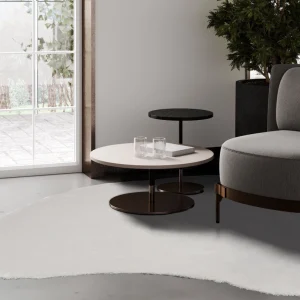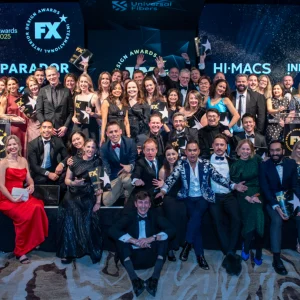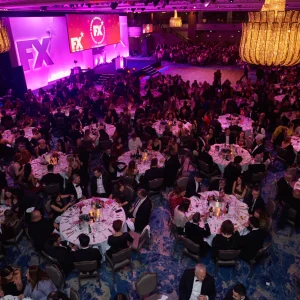THERE ARE MANY fascinating things within the eclectic intellectual smorgasbord of science, civic infrastructure, shamanism and art that the Science Gallery’s curators have conjured for their new show at this London Bridge cultural landmark, part of King’s College London (KCL) – but two artworks pack a particular punch.
One is a poetic illustration of the connection between sign language – both Visual Vernacular and Chinese Sign Language (CSL) – and the natural world. In a newly commissioned, immersive audio-visual work – Night Bloom, by Cathy Mager and deaf-led collective Spectroscope – three classically trained Chinese dancers incorporate into a dance the symbols for trees, roots and flowers, among other natural world phenomena. Each gesture seems vividly evocative of the thing it represents – for example, a tree is an upheld hand, fingers splayed, ‘roots’ are the same finger shape but with the hand dangling. Meanwhile, illustrated animations of floral and insect landscapes bloom on the screen, then fade and fragment around the dancers. The work is reflecting on the potential, as well as the experience of discrimination and erasure, of the global deaf community. It’s a beautiful cry for compassion for the planet, and all its occupants.
 Night Bloom by Cathy Mater and Spectroscope blends sign language with immersive visuals reflecting on our relationship with nature
Night Bloom by Cathy Mater and Spectroscope blends sign language with immersive visuals reflecting on our relationship with nature
The other memorable work takes the most basic human function – excretion of waste – and turns it into a thought-provoking and visually rich installation. Gayle Chong Kwan’s I am the Thames and the Thames is Me is inspired by a Maori saying the artist heard on a residency in New Zealand, ‘I am the River and the River is Me’, which was tied to a recent landmark legal ruling granting personhood for the Whanganui River in Aotearoa. It also emerged from a deep delve into King’s College London’s archives on the history of river-borne disease and pollution, emerging from our careless and casual treatment of the Thames, and the game-changing introduction of the London sewerage system, thanks to 19th-century plumbing pioneer Joseph Bazalgette.
Science Gallery curator Jennifer Wong tells me: ‘Gayle is asking: How do we change our relationship to the river and consider the river’s health more?’ To that end, the artist has created eight ‘river guardians’, who are posted around the gallery, on plinths made from rough-hewn wood to resemble river piers, wearing indigo clothes Chong Kwan dyed and patterned using items found in the Thames (plus her own urine – once a traditional ingredient in dyeing alchemy). These figures are embellished with clay items that were fired with a glaze that incorporates the ashes of actual human dung. Yes, we’re squeamish about that kind of thing, but, on reflection, I realise we’re only entitled to be so squeamish thanks to the past 200 years of sanitary and sewage system advances. The artist used the glazes on ceramic necklaces worn by the guardians, and rather realisticlooking strings of ceramic coprolites (fossilised poop) under their skirts. Chong Kwan sourced the ashes from Thames Water sewerage works where, it turns out, experiments have successfully managed to turn waste into breeze blocks. The guardians, says Wong, ‘symbolise protection and stewardship, health inequalities in the capital and collective action’. (I’m not sure collective action is the priority at present, compared to holding to account the profit hungry water company owners who behave so carelessly with our drinking water and waste.)
 Gayle Chong Kwan’s ‘river guardians’
Gayle Chong Kwan’s ‘river guardians’
The husbandry of water resources is only going to get more urgent as climate change impacts hit home. And sparking conversations around this and other issues of climate change is what the curators, both Wong and her colleague Laura Purseglove, hope to achieve.
Just beyond Chong Kwan’s installation, artist collective The Centric Lab is pondering another crucial element: the air we breathe. I’d call this less artistry, more infographics: the touch-screen display gives us access to five different UK regions, where maps reveal evidence of ‘sacrifice zones’ – in that the worst road pollution occurs in the areas of greatest economic and social deprivation.
 An immersive audiovisual work by Cathy Mager and and the deaf-led collective Spectroscope
An immersive audiovisual work by Cathy Mager and and the deaf-led collective Spectroscope
Although UK issues feature, the curators have drawn from global perspectives and practices to reinforce that these issues are universal – and not all are so deadly serious. One quirky installation by artists Katherine Swancutt, Jan Karlach and Zuoxi Yueqi, called Cosmological Visionaries, explores the beliefs of a Tibeto-Burmese community, called the Nuosu, based in south-west China, whose mythologies attribute personhood to many elements in the landscape. They have proved surprisingly adaptable, even as green technologies – wind farms in particular – march over their territory. More winningly, their priests or shamans have found a way to share rituals for cleansing unwelcome elements in their surroundings of their ability to bring harm via the Chinese-governed social media tool WeChat. In this way, says Wong, ‘they bring communities together’
If all this hard thinking about tough questions has proved too much, artist Birungi Kawooya has provided us with some soft spaces for reflection: three tepees made of bark fabric. Kawooya discovered this regenerative practice in Uganda, where her family originates, of stripping bark from a tree but then bandaging the tree in banana leaves, which helps the tree to regrow a new skin. The tepees are supported on bamboo poles sourced sustainably in Brixton.
 Birungi Kawooya’s tepees offer a place for rest and reflection
Birungi Kawooya’s tepees offer a place for rest and reflection
In the foyer of this exhibition, a ‘Living Library’ has been created, with noticeboards and films sharing some of the climate research and thinking of many King’s College scientists and environmental thinkers, as well as books and other resources.
But just to lighten things up, the bean bags and chairs provided for individual contemplation have been painted with heat-reactive pigmented ink, so that your hand (or bottom) leaves a warm glow after occupancy. ‘It’s a way of saying we all leave traces in the world around us,’ says Wong. But what a fun way of saying it.





